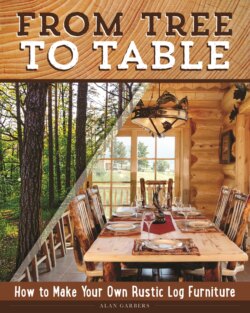Читать книгу From Tree to Table - Alan Garbers - Страница 11
На сайте Литреса книга снята с продажи.
ОглавлениеCHAPTER 3 STYLES OF FURNITURE
Not all log furniture is the same. Different regions of the country have developed different styles. Almost all of these styles are rooted in the materials available locally.
Northwoods
Much of the furniture found in the North and Northeast rely heavily on birch, and for good reason. Birch has beautiful white bark that can be used as a veneer on furniture. The dark twigs have a distinctive pattern of lenticels that match the lenticel pattern on the birch bark itself.
This Northwoods style of furniture is generally more graceful and complex than other styles. It has been a favorite of furniture lovers for a hundred years or more.
Northwoods-styled furniture is often dominated by birch bark and smaller-diameter wood pieces. The rocker on the left appears to be a more elegant birch and maple combination characteristic of Northwoods pieces.
Midwestern
In the Midwest, hickory is the dominant wood used for furniture. While there are several species of hickory, all have appealing bark patterns that are adored by rustic furniture lovers around the country. Visit just about any lodge in national or state parks and you’ll most likely find examples of hickory furniture, some still in use after generations. Old Hickory Furniture in Shelbyville, Indiana, is still producing high-quality pieces to this day.
Hickory dominates pieces that come from the Midwest. The classic bark pattern is very appealing and rugged.
Western
Western log furniture is often made with massive aspen logs, western junipers, and pines. Opposite of the log furniture made in the eastern U.S., western furniture is often oversized, as if to mirror the vastness of the West.
Since the humidity is so low in the western U.S., rot and termites are much less likely to destroy downed wood when compared to the humid eastern U.S. In the arid west, downed wood often dries before damage can set in. As the wood weathers, it takes on a great hue and texture. Artists in the field often use these twisted and weathered wood pieces in their furniture, as well as elk and deer antlers as accents.
Aspen logs that show signs of insect distress dominate the lodges throughout the western United States. It’s easy to see why they’re so popular.
Southwestern
The furniture history of the Southwest is a rich tapestry. The Spanish colonized parts of Texas, New Mexico, Arizona, and California in the 1500s. The travel route to bring up their belongings from Mexico was more than a thousand miles long over treacherous terrain, so furniture from civilization was limited.
As settlers moved west, they too had little in the way for furniture. At the same time, items that were shipped west were packed in wooden crates and boxes. It was a rare thing that any of the lumber from the crates went unused. It is well documented in journals that crates were pressed into service as almost anything that pioneers needed. Arbuckle’s Coffee came in 100-pound (45 kg) crates, which were coveted for their lumber and used for anything from kitchen cabinets to coffins. In the late 1800s, the majority of coffee sold in Arizona was Arbuckle’s brand coffee.
The Sharlot Hall Museum in Prescott, Arizona, has an extensive collection of furniture pieces from the pioneer era. Many of them are made of crate and box lumber.
As dude ranches became popular in the early 1900s, folks scrambled for anything western in style. Furniture often included cattle horns and leather.
These days, Southwestern style encompasses the rich tapestry of the culture and includes elements from the Native American, Spanish, pioneer, and ranching influences. Since the woods found can be so diverse, they often include everything from juniper and ponderosa to creosote and saguaro wood.
